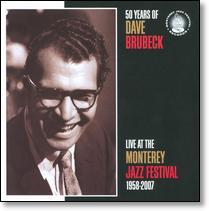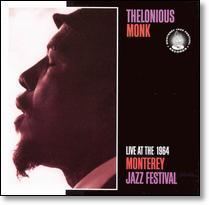A Consumer Guide to the Trailing Edge: September, 2008
Recycled Goods (#57)
by Tom Hull
 |
 |
I meant to feature the Soprano Summit album as my first pick hit, but couldn't find a cover shot in my usual place, and didn't have time to scrounge one up, let alone scan my copy. Release date is Sept. 9, so the capitalists are running a bit slow, not to mention scared. So my fallback was to avoid having to choose the better of the two best entries in the Monterey Jazz Festival series -- actually, two batches thus far.
Justin Time Records 25th Anniversary Collection (1986-2007 [2008], Justin Time, 2CD): Canadian jazz label, with some folk, blues, and world overtones. Got into the business in 1983 with pianist Oliver Jones; has a long list of jazz singers, including the discovery of Diana Krall, and steady work by Jeri Brown and Susie Arioli; scored their biggest coup in landing David Murray in 1996, who led them to Billy Bang, D.D. Jackson, and Hugh Ragin. Sidelines not documented here include their Just A Memory archival series and reissues from Enja's catalog. All this adds up to an eclectic sampler, with high points from great albums and filler from weaker ones, unnecessary except to draw attention to a label that's long been worth following. B
The Soprano Summit: In 1975 and More (1975-79 [2008], Arbors, 2CD): Clarinetist Kenny Davern and saxophonst Bob Wilber, two impeccably backward-looking players, ran into each other in Colorado in 1972, finding common ground as a soprano sax duo dedicated to Sidney Bechet. Their summits continued through the 1970s, with occasional reunions into 2001, sometimes with pianist Dick Hyman and other kindred souls -- guitarist Marty Grosz is prominent here, but Bucky Pizzarelli also played. Dan Morgenstern picked these sessions from the archives, including one from April 1975 focusing on Jelly Roll Morton, and two non-Summit sets: a Davern trio with pianist Dick Wellstood from 1979, and a 1976 Wilber group with Ruby Braff. The album never strays from the soprano range, but lively rhythm sections make up for the lack of contrasting horns. Superb trad jazz. A-
In Series
Have franchise, seeking product. First batch came out last year, with the Miles Davis getting some year-end critics poll votes. It skimmed the biggest of the big names, with relative obscurities this time around. Like the archival records that keep coming out on European labels -- TCB's series comes closest, especially given their tie-in with the Montreux Jazz Festival -- these rarely add anything new to well documented careers, but sort of democratize claims on the greats. With few really spectacular performances, and even fewer poor ones, they tend toward the middle grades. The B+ records from top to bottom: Blakey, Horn, Armstrong, Davis, Tjader, Gillespie, Puente.
Louis Armstrong: Live at the 1958 Monterey Jazz Festival (1958 [2007], MJF): Well, if you've heard one Armstrong live set, you'll probably want to hear them all; post-All Stars, so there's less reason to share the stage; late enough that those "good ole good 'uns" include "Mack the Knife." B+
Art Blakey and the Giants of Jazz: Live at the 1972 Monterey Jazz Festival (1972 [2008], MJF): Not a happy period in the drummer's career, but he plays with great physicality here, leading a ragtag crew of superstars in what could pass as a Jazz at the Philharmonic blowout; Roy Eldridge, Clark Terry, Sonny Stitt, and Kai Winding are natural jousters who offers great excitement but no surprises; the mystery is left to the troubled pianist in one of his last performances, but Thelonious Monk comps engagingly and takes a nice feature on "'Round Midnight." B+
Dave Brubeck: 50 Years of Dave Brubeck: Live at the Monterey Jazz Festival 1958-2007 (1958-2007 [2008], MJF): Starts with Paul Desmond for three 1958-66 quartet cuts and closes with three 2002-07 quartets with Bobby Militello on alto sax -- a sense of continuity and balance unlikely in any 50-year span; Gerry Mulligan figures in between, and only one cut lacks a horn, but the unique pacing of the pianist comes through again and again. A-
Miles Davis Quintet: Live at the 1963 Monterey Jazz Festival (1963 [2007], MJF): Early into the second great Davis Quintet, with Herbie Hancock, Ron Carter, and Tony Williams on board, along with George Coleman on tenor sax; compared to the live albums from 1964, this seems tentative and thin, reworking old repertoire, with a few hints of the future. B+
Dizzy Gillespie: Live at the 1965 Monterey Jazz Festival (1965 [2007], MJF): Small group with James Moody (flute, tenor sax), Kenny Barron (piano), and Big Black (congas), running through a mixed bag of bebop, with the calypso "Poor Joe" thrown in for Gillespie's vocal; sound is a little thin, and it's all very slapdash, not least the comedy. B+
Shirley Horn: Live at the 1994 Monterey Jazz Festival (1994 [2008], MJF): Very cost-effective: a singer with such voice and poise a piano trio suits her best, plus she plays a pretty mean piano; just turned 60, at the peak of her fame coming off a series of well-regarded albums on Verve, she nails her whole range here -- "The Look of Love," "A Song for You," "I've Got the World on a String," "Hard Hearted Hannah." B+
Thelonious Monk: Live at the 1964 Monterey Jazz Festival (1964 [2007], MJF): Four terrific quartet tracks, with tenor saxophonist Charlie Rouse in splendid form, and the pianist especially delightful on "Bright Mississippi" -- a Monkified "Sweet Georgia Brown"; five extra horns show up for the Buddy Collette-sketched encores, with hot boppish trumpet and more funky piano. A-
Tito Puente & His Orchestra: Live at the 1977 Monterey Jazz Festival (1977 [2008], MJF): A typical set by the great timbalero and his venerable orchestra, featuring signature tunes like "Oye Como Va" and "El Rey del Timbal," rhumbas and mambos, a dash of riskier Afro-Cuban jazz, and a cha cha take on Stevie Wonder. B+
Cal Tjader: The Best of Cal Tjader: Live at the Monterey Jazz Festival 1958-1980 (1958-80 [2008], MJF): A short set from 1958 with Buddy DeFranco bebop over the vibraphonist's Latin stew, and four choice 1972-80 shots, starting with Dizzy Gillespie and Clark Terry teaching him how to play "Manteca." B+
Sarah Vaughan: Live at the 1971 Monterey Jazz Festival (1971 [2007], MJF): A singer I've never much liked even though sometimes I can hear some of what others hear in her -- the unworldly deep voice, the extraordinary precision and uncanny musican sense in her dynamics; this is not the place to start: her range is narrowed by time and most likely by acoustics, and she scats way too much -- especially in the blistering all-star jam that takes up the last third of the album. B
Jimmy Witherspoon: Live at the 1972 Monterey Jazz Festival (1959-72 [2008], MJF): The last of the Kansas City blues shouters, in a surly mood that could pass for spirit if you cut him some slack; his Jimmy Rushing tribute is heartfelt but not up to snuff; his praise for guitarist Robben Ford is earned but not such a big deal; the bonus track from 1959 towers above the later performance, not just because Messrs. Hines, Herman, Hawkins, Webster, and Eldridge are in the band, but they sure help. B
Briefly Noted
Cryptogramophone Assemblage 1998-2008 (1998-2007 [2008], Cryptogramophone, 2CD+DVD): Another jazz label sampler, founded by Jeff Gauthier to record a series of tributes to the late Eric von Essen's music, moving on to document work by Alex and Nels Cline, Mark Dresser, Bennie Maupin, Erik Friedlander, Myra Melford, various others; a more useful reference than the Justin Time sampler -- it covers a narrower band of music more comprehensively, with better documentation -- but still a mere sampler. B
Otis Redding: Live in London and Paris (1967 [2008], Stax, 2CD): Two live shows from March of the monumental soul singer's last year, most songs duplicated in both sets, distinguished primarily by the intensity of his performance, a rave-up that can get to be too much, although the rush cannot be denied. B+
Tuner: Totem (2005 [2008], Unsung): King Crimson drummer Pat Mastelotto and guitarist Markus Kreuter mash up some quasi-industrial thrash with scattered and mostly ignorable vocals; first album, remixed and reissued, keeps it simple, which works much better than guest-laden follow-up Pole. B+
Additional Consumer News
Notes
Copyright © 2008 Tom Hull.